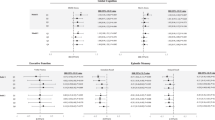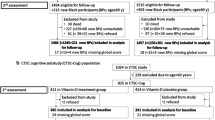Abstract
Both high and low vitamin D statuses have been associated with lower memory function. Apolipoprotein E (APOE) ɛ4 alleles have been associated with reduced memory function, and separately with higher vitamin D concentrations. This report aims to examine if the presence of APOE ɛ4 alleles contributes to the relationship between vitamin D and memory function. A total of 4848 (46% female) participants from the 1958 British birth cohort had information on APOE genotypes and completed memory tests at 50 years, where 4644 also had 25-hydroxyvitamin D (25(OH)D) concentrations measured at 45 years. Both low and high 25(OH)D concentrations were associated with lower memory function after adjustment for number of APOE ɛ4 alleles (Pcurvature=0.02). There was evidence of interaction between APOE ɛ4 and 25(OH)D, suggesting the association between 25(OH)D concentrations and memory function is different for those with two APOE ɛ4 alleles compared with those with zero or one APOE ɛ4 alleles (recessive model Pinteraction=0.01). Among participants with two APOE ɛ4 alleles, higher 25(OH)D concentrations were associated with higher memory function, whereas in others, memory scores were slightly lower for individuals with higher versus lower concentrations. Further studies are required to replicate these findings.
This is a preview of subscription content, access via your institution
Access options
Subscribe to this journal
Receive 12 print issues and online access
$259.00 per year
only $21.58 per issue
Buy this article
- Purchase on Springer Link
- Instant access to full article PDF
Prices may be subject to local taxes which are calculated during checkout

Similar content being viewed by others
References
Kramer AF, Bherer L, Colcombe SJ, Dong W, Greenough WT . Environmental influences on cognitive and brain plasticity during aging. J Gerontol A Biol Sci Med Sci 2004; 59: M940–M957.
Lövdén M, Xu W, Wang H-X . Lifestyle change and the prevention of cognitive decline and dementia: what is the evidence? Curr Opin Psychiatry 2013; 26: 239–243.
Balion C, Griffith LE, Strifler L, Henderson M, Patterson C, Heckman G et al. Vitamin D, cognition, and dementia: a systematic review and meta-analysis. Neurology 2012; 79: 1397–1405.
Breitling LP, Perna L, Muller H, Raum E, Kliegel M, Brenner H . Vitamin D and cognitive functioning in the elderly population in Germany. Exp Gerontol 2012; 47: 122–127.
Maddock J, Geoffroy M-C, Power C, Hyppönen E . 25-Hydroxyvitamin D and cognitive performance in mid-life. Br J Nutr 2014; 111: 904–914.
Small BJ, Rosnick CB, Fratiglioni L, Backman L . Apolipoprotein E and cognitive performance: a meta-analysis. Psychol Aging 2004; 19: 592–600.
Egert S, Rimbach G, Huebbe P . Symposium on 'Metabolic flexibility in animal and human nutrition'Session IV: Nutritional compounds for optimised healthspan and life performance: ApoE genotype: from geographic distribution to function and responsiveness to dietary factors. Proc Nutr Soc 2012; 71: 410–424.
Power C, Elliott J . Cohort profile: 1958 British birth cohort (National Child Development Study). Int J Epidemiol 2006; 35: 34–41.
Atherton K, Fuller E, Shepherd P, Strachan DP, Power C . Loss and representativeness in a biomedical survey at age 45 years: 1958 British birth cohort. J Epidemiol Community Health 2008; 62: 216–223.
Voight BF, Kang HM, Ding J, Palmer CD, Sidore C, Chines PS et al. The metabochip, a custom genotyping array for genetic studies of metabolic, cardiovascular, and anthropometric traits. PLoS Genet 2012; 8: e1002793.
Wadsworth M, Kuh D, Richards M, Hardy R . Cohort profile: The 1946 National Birth Cohort (MRC National Survey of Health and Development). Int J Epidemiol 2006; 35: 49–54.
Llewellyn DJ, Lang IA, Langa KM, Huppert FA . Cognitive function and psychological well-being: findings from a population-based cohort. Age Ageing 2008; 37: 685–689.
Hyppönen E, Turner S, Cumberland P, Power C, Gibb I . Serum 25-hydroxyvitamin D measurement in a large population survey with statistical harmonization of assay variation to an international standard. J Clin Endocrinol Metab 2007; 92: 4615–4622.
Kirkwood BR, Sterne JA . Multiple regression. Medical Statistics. Blackwell Science Ltd: Oxford, 2003, pp 98–106.
Goldberg DP, Cooper B, Eastwood MR, Kedward HB, Shepherd M . A standardized psychiatric interview for use in community surveys. Br J Prev Soc Med 1970; 24: 18–23.
Lewis G, Pelosi AJ, Araya R, Dunn G . Measuring psychiatric disorder in the community: a standardized assessment for use by lay interviewers. Psychol Med 1992; 22: 465–486.
Clayton D, Hills M Statistical Models in Epidemiology. Oxford University Press: Oxford, 1993.
Eyles DW, Smith S, Kinobe R, Hewison M, McGrath JJ . Distribution of the vitamin D receptor and 1 alpha-hydroxylase in human brain. J Chem Neuroanat 2005; 29: 21–30.
Eyles D, Brown J, Mackay-Sim A, McGrath J, Feron F . Vitamin D3 and brain development. Neuroscience 2003; 118: 641–653.
Brown J, Bianco JI, McGrath JJ, Eyles DW . 1, 25-Dihydroxyvitamin D(3) induces nerve growth factor, promotes neurite outgrowth and inhibits mitosis in embryonic rat hippocampal neurons. Neurosci Lett 2003; 343: 139–143.
Oermann E, Bidmon HJ, Witte OW, Zilles K . Effects of 1alpha, 25 dihydroxyvitamin D3 on the expression of HO-1 and GFAP in glial cells of the photothrombotically lesioned cerebral cortex. J Chem Neuroanat 2004; 28: 225–238.
Brewer LD, Thibault V, Chen KC, Langub MC, Landfield PW, Porter NM . Vitamin D hormone confers neuroprotection in parallel with downregulation of L-type calcium channel expression in hippocampal neurons. J Neurosci 2001; 21: 98–108.
Moore M, Piazza A, McCartney Y, Lynch M . Evidence that vitamin D3 reverses age-related inflammatory changes in the rat hippocampus. Biochem Soc Trans 2005; 33: 573–577.
Bao BY, Ting HJ, Hsu JW, Lee YF . Protective role of 1 alpha, 25-dihydroxyvitamin D3 against oxidative stress in nonmalignant human prostate epithelial cells. Int J Cancer 2008; 122: 2699–2706.
Dursun E, Gezen-Ak D, Yilmazer S . A novel perspective for Alzheimer's disease: vitamin D receptor suppression by Amyloid-β and preventing the Amyloid-β induced alterations by vitamin D in cortical neurons. J Alzheimers Dis 2011; 23: 207–219.
Brewer LD, Porter NM, Kerr DS, Landfield PW, Thibault O . Chronic 1α, 25-(OH)2 vitamin D3 treatment reduces Ca2+-mediated hippocampal biomarkers of aging. Cell Calcium 2006; 40: 277–286.
Wolf PA . Stroke risk profiles. Stroke 2009; 40: S73–S74.
Barnard K, Colon-Emeric C . Extraskeletal effects of vitamin D in older adults: cardiovascular disease, mortality, mood, and cognition. Am J Geriatr Pharmacother 2010; 8: 4–33.
Schipper HM . Apolipoprotein E: implications for AD neurobiology, epidemiology and risk assessment. Neurobiol Aging 2011; 32: 778–790.
Lemire J . 1, 25-Dihydroxyvitamin D3–a hormone with immunomodulatory properties. Z Rheumatol 2000; 59: I24–I27.
Zhang HL, Wu J, Zhu J . The role of apolipoprotein E in Guillain-Barré syndrome and experimental autoimmune neuritis. J Biomed Biotechnol 2010; e-pub ahead of print 16 February 2010; doi:10.1155/2010/357412.
Maier SF . Bi-directional immune–brain communication: implications for understanding stress, pain, and cognition. Brain Behav Immun 2003; 17: 69–85.
Jorm AF, Mather KA, Butterworth P, Anstey KJ, Christensen H, Easteal S . APOE genotype and cognitive functioning in a large age-stratified population sample. Neuropsychology 2007; 21: 1.
Christensen H, Batterham PJ, Mackinnon AJ, Jorm AF, Mack HA, Mather KA et al. The association of APOE genotype and cognitive decline in interaction with risk factors in a 65–69 year old community sample. BMC Geriatrics 2008; 8: 14.
Acknowledgements
We are grateful to all the participants in the 1958BC. We acknowledge Professor I Gibb, Dr S Turner and M-C Fawcett (Royal Victoria Infirmary, Newcastle-upon-Tyne, UK) for carrying out the laboratory assays and the Centre for Longitudinal studies, Institute of Education (original data producers), for providing the data. JM holds a UCL Impact studentship. The Medical Research Council funded the 2002–2004 clinical follow-up of the 1958 birth cohort (grant G0000934), 25(OH)D assays were funded by the BUPA Foundation. Further support was obtained from the Jeans for Genes, the UK Medical Research Council (grant G0601653 and SALVE/PREVMEDSYN with Academy of Finland). Research at the University College London Institute of Child Health and Great Ormond Street Hospital for Children NHS Trust benefits from R&D funding received from the NHS Executive. All mentioned funders had no role in the design, analysis or writing of this article.
Author information
Authors and Affiliations
Corresponding authors
Ethics declarations
Competing interests
The authors declare no conflict of interest.
Additional information
Supplementary Information accompanies this paper on European Journal of Clinical Nutrition website
Supplementary information
Rights and permissions
About this article
Cite this article
Maddock, J., Cavadino, A., Power, C. et al. 25-Hydroxyvitamin D, APOE ɛ4 genotype and cognitive function: findings from the 1958 British birth cohort. Eur J Clin Nutr 69, 505–508 (2015). https://doi.org/10.1038/ejcn.2014.201
Received:
Revised:
Accepted:
Published:
Issue Date:
DOI: https://doi.org/10.1038/ejcn.2014.201
This article is cited by
-
Alzheimer’s disease risk reduction in clinical practice: a priority in the emerging field of preventive neurology
Nature Mental Health (2024)
-
Ideal vitamin D and handgrip strength counteracts the risk effect of APOE genotype on dementia: a population-based longitudinal study
Journal of Translational Medicine (2023)
-
Factors Influencing Alzheimer’s Disease Risk: Whether and How They are Related to the APOE Genotype
Neuroscience Bulletin (2022)
-
A Scoping Review of Dietary Factors Conferring Risk or Protection for Cognitive Decline in APOE ε4 Carriers
The Journal of nutrition, health and aging (2021)
-
The Role of Nutrition in Individualized Alzheimer’s Risk Reduction
Current Nutrition Reports (2020)



